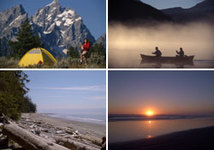The unofficial BC Travel & Tourism Guide
Spipiyus

Activities include hiking and wildlife viewing. Hiking trails and old logging roads give views of the Gulf Islands, Pender Harbour, the Strait of Georgia, and Vancouver Island. An excellent viewpoint is provided by a restored fire tower, one of the last remaining fire lookouts in British Columbia, on Mt. Hallowell.
Wildlife includes black bear, roosevelt elk, cougar, bobcat, black tailed deer, snowshoe hares and river otters. Birdlife includes mew gulls, barrows goldeneye, bald eagles, ospreys and belted kingfishers, as well as the park’s namesake marbled murrelet, whose endangered status and dependence on old-growth have made it the flagship species in the forest preservation movement.
Camping:
There are no camping or picnicking facilities provided in this park. However, it is co-managed and stewarded by the The Sechelt Native Band and the Friends of Caren Range.
Location and access:
Spipiyus Provincial Park is located on the Sechelt Peninsula on the Sunshine Coast, which is a short ferry trip and drive north-west of Vancouver. To access the park take Highway 101 for 11 km north of Sechelt, turn north just before Half-Moon Bay on Trout Lake Road and proceed up this logging road to the main junction at kilometre 12. Take the left fork, continue to kilometre 19.5, and park at the trailhead. Nearby communities include Sechelt and Gibsons.
Just click on the following links for more information about nearby communities such as
